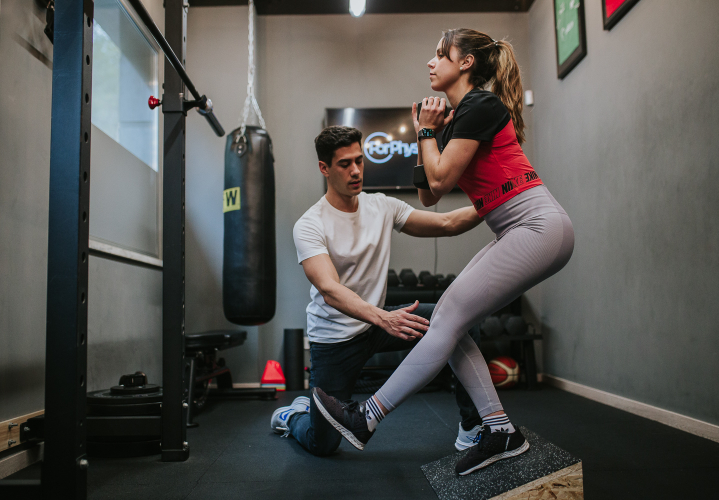Physical exercise based on movement patterns
How to Prescribe Exercise to Improve Physical Performance and Rehabilitate Injuries
- Exercise Prescription

What are movement patterns? Movement patterns are natural sequences of movements the body performs to carry out everyday functional tasks or specific physical activities. These patterns involve the coordinated use of multiple joints and muscle groups in an integrated way, allowing the body to move efficiently and safely. There are different ways and terminologies to categorize physical exercises based on their biomechanical demands. Classifying exercises based on movement patterns makes it easier for professionals to identify the most suitable exercise for their client or athlete. This method of prescribing physical exercises allows for the creation of an individualized training or rehabilitation plan tailored to the goals defined during the assessment. What are the basic movement patterns? There are six fundamental movement patterns that form the basis for more advanced movements. These patterns represent essential motor actions that serve as the foundation for training, rehabilitation, and physical performance. 1. Squat This involves simultaneous flexion and extension of the hip, knee, and ankle joints while maintaining a stable and aligned posture. This pattern is essential for actions such as sitting and standing up, forming the basis for many strength exercises. 2. Hinge Refers to hip-dominant movement with minimal knee flexion, focusing on activating the hamstrings and glutes. This pattern is crucial for lifting objects off the ground and reducing the risk of lower back injuries. 3. Gait Involves unilateral lower limb movements that challenge balance, stability, and strength in different planes. This pattern is utilized in walking, changing directions, and everyday movements. 4. Pull Represents a movement pattern where an object or the body itself is brought toward the center of gravity, as in rows. This pattern is essential for strengthening the back, shoulders, and arms. 5. Push Includes actions of pushing an object or the body itself away, as in push-ups. This pattern mainly uses the pectoral muscles, deltoids, and triceps, being indispensable for activities involving upper body strength. 6. Stabilize Refers to the ability to keep the torso stable and aligned during dynamic or static movements. This pattern serves as the foundation for force transfer between the upper and lower limbs.
Importance of Movement Patterns Fundamental movement patterns are interdependent and form the basis for more complex movements. Training and mastering the technique for these patterns is essential to improving physical performance, reducing the risk of injury, and enhancing functionality in everyday activities. Each pattern should be assessed, corrected, and refined based on individual goals, considering factors such as mobility, stability, strength, and motor control. How do we prescribe exercise based on movement patterns at ForPhysio? At ForPhysio, exercise prescription based on movement patterns is a functional approach, focusing on the body’s various movements. When creating a program, it is essential that exercises are selected based on their function and utility for the client or athlete, not their attractiveness or difficulty. Here is a summary of how we design exercise plans at ForPhysio: Posture: • Lying down, four points, sitting, kneeling, half-kneeling, bipodal (two legs), unipodal (one leg) with support, and unipodal; Movement and Direction: • Lower Limbs ◦ Hip Dominant and Knee Dominant • Upper Limbs ◦ Vertical Push and Horizontal Push ◦ Vertical Pull and Horizontal Pull • Trunk Muscles (Core) ◦ Dynamic: Flexion, Extension, Lateral Flexion, Rotation, and Diagonal ◦ Static: Anti-Rotation, Anti-Flexion, Anti-Extension, and Anti-Lateral Flexion Emphasis: • Bilateral • Unilateral • Alternating Based on the above items, the professional can prescribe a competent and varied exercise plan, incorporating most existing exercises. However, it’s important to note that there are movement patterns (listed above) and movement axes. In this last category, body movements are described through joint movements, such as: • Internal and External Rotation • Adduction and Abduction • Flexion and Extension Here’s an example of an exercise plan, purely illustrative, prescribed based on movement patterns. Training Plan – Practical Example with 6 Exercises Hip Dominant: Deadlift with barbell; 3 sets of 6 reps Horizontal Push: Inclined push-ups; 3 sets of 8 reps Knee Dominant: Squat with barbell; 3 sets of 6 reps Vertical Pull: Pull-ups; 3 sets of 5 reps Vertical Push: Alternating shoulder press with dumbbells; 3 sets of 12 reps Static Core: Side plank; 3 sets of 30 seconds Dynamic Core: Trunk flexion; 3 sets of 16 reps I urge that exercise plans should always be carried out by a certified professional and tailored to each client or athlete.


